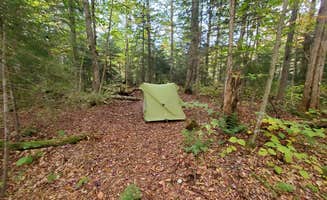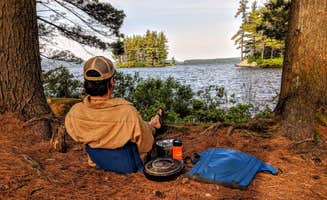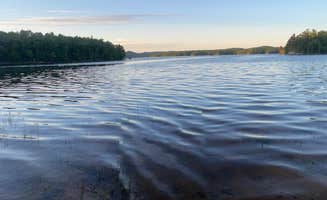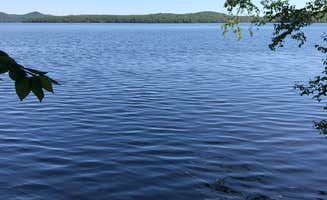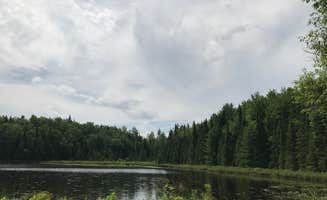Dispersed camping opportunities near Tupper Lake, New York extend beyond the well-known sites on Stillwater Reservoir and Cranberry Lake. The region sits within the six-million-acre Adirondack Park at elevations ranging from 1,500 to 2,000 feet, creating distinct seasonal considerations for campers. Roads accessing primitive sites often remain unmaintained, with many requiring high-clearance vehicles during spring mud season when overnight temperatures can still drop below freezing through May.
What to do
Climb local fire towers: Ward Brook Campsite provides convenient access to multiple Adirondack peaks. "Great campsite with a nice lean-to. Fire pit, picnic table, and a privy. A bit further you will find some tent spots too. Plenty of water around," notes camper Alex R. about this basecamp for hiking Seymour Mountain.
Paddle and island-hop: Seventh Lake Primitive Camping offers water-access camping with distinctive features. According to MARY B., "There is a large sand bar within a very short walk which was a great place to hang out. Seventh lake is pretty quiet but there were a few boats there both days we visited."
Wildlife photography: The reservoir areas host abundant loons, eagles, and beaver activity. Christie M. from Stillwater Reservoir reports, "We saw Bald Eagles and Loons, enjoyed swimming, canoeing and paddleboarding with the family."
What campers like
Complete disconnection: Primitive camping near Tupper Lake means minimal connectivity. Dane P. describes Stillwater Reservoir: "A 20 mile ride of just woods on a bumpy road. Pretty cool! Surprisingly the place wasn't that populated as I expected it to be."
Sandy beaches: Several sites feature natural beach areas ideal for swimming. Elizabeth B. at Stillwater notes, "Our spot had gorgeous waterfront to it, a stone fire circle where someone had left extra fire wood, and ample trees. The season had had unusually low water all over and it left a really unusual landscape on the beach to explore."
Designated sites with basic infrastructure: Little Green Pond offers established sites with simple amenities. "12 designated camping spots. Some require driving down a bumpy access road that can be muddy after a rain. Sites are on the Pond. Pond has a small beach to swim. Tree covered sites," writes Lo M.
What you should know
Vehicle considerations: Many access roads require appropriate vehicles. Rebecca B. at Horseshoe Lake advises, "Road is rough but easily doable if you take it slow. As it's a forest, the sites are pretty shaded, so solar and Starlink may present challenges. Slight AT&T at earlier sites."
Limited supplies: Most primitive camping near Tupper Lake requires self-sufficiency. One Cranberry Lake Backcountry camper explains, "The Village of Cranberry Lake has some supplies, but not much except the very basics at the general store. You'll need to head to Star Lake or Tupper Lake for anything of significance."
Weather variability: The Adirondack region experiences rapid weather changes, especially in shoulder seasons. At Stillwater Reservoir, Sam T. shares, "My wife and I kayaked to Long Island and stayed for a weekend. It was quiet and had the whole island to our self. Would recommend if you want to break away from technology because you get zero service out there."
Tips for camping with families
Select sites with swimming options: Cranberry Lake Backcountry Sites offer family-friendly water access. Kristal Ann F. notes, "Beautiful campgrounds... clean.. friendly.. amazing lake for kayaking and boating. Sites not crowded together."
Bring water filtration: Families need reliable water sources. Sam T. advises about Stillwater: "The only car accessible campsite was a great camp site very big and had a trail that lead down to the water. This campsite is right down the road from the fire tower trail."
Plan for bugs: Insect protection is essential for family comfort. One camper at Polliwog Lake states, "Camped here for a few days, no cell, no internet," highlighting the need for offline entertainment options for children.
Tips from RVers
Limited RV accessibility: Most primitive sites cannot accommodate larger rigs. Kane from Stillwater Reservoir cautions, "I came here a couple days ago only to realize that all except one campsite needs a boat to be reached. It's first come first serve so best to find another place if you intend to drive up to your campsite."
Prepare for extended stays: RV campers should bring ample supplies. Joseph S. notes about Stillwater, "Having both camped, and trained with my SAR Unit, on Stillwater Reserve, I must say it's a wonderful place to get lost voluntarily at least!"
Check road conditions: Forest roads can change seasonally. One Stillwater visitor reported a five-hour drive to reach the campground, emphasizing the importance of current road information when bringing an RV or trailer to primitive sites.


